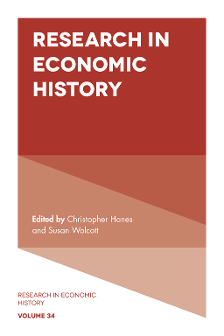
Prelims
ISBN: 978-1-78756-582-1, eISBN: 978-1-78756-581-4
ISSN: 0363-3268
Publication date: 22 August 2018
Citation
(2018), "Prelims", Research in Economic History (Research in Economic History, Vol. 34), Emerald Publishing Limited, Leeds, pp. i-ix. https://doi.org/10.1108/S0363-326820180000034006
Publisher
:Emerald Publishing Limited
Copyright © 2018 Emerald Publishing Limited
Half Title Page
RESEARCH IN ECONOMIC HISTORY
Series Page
RESEARCH IN ECONOMIC HISTORY
Series Editors: Christopher Hanes and Susan Wolcott
Title Page
RESEARCH IN ECONOMIC HISTORY VOLUME 34
RESEARCH IN ECONOMIC HISTORY
EDITED BY
CHRISTOPHER HANES
Binghamton University, State University of New York, USA
SUSAN WOLCOTT
Binghamton University, State University of New York, USA

United Kingdom – North America – Japan – India – Malaysia – China
Copyright Page
Emerald Publishing Limited
Howard House, Wagon Lane, Bingley BD16 1WA, UK
First edition 2018
Copyright © 2018 Emerald Publishing Limited
Reprints and permissions service
Contact: permissions@emeraldinsight.com
No part of this book may be reproduced, stored in a retrieval system, transmitted in any form or by any means electronic, mechanical, photocopying, recording or otherwise without either the prior written permission of the publisher or a licence permitting restricted copying issued in the UK by The Copyright Licensing Agency and in the USA by The Copyright Clearance Center. Any opinions expressed in the chapters are those of the authors. Whilst Emerald makes every effort to ensure the quality and accuracy of its content, Emerald makes no representation implied or otherwise, as to the chapters’ suitability and application and disclaims any warranties, express or implied, to their use.
British Library Cataloguing in Publication Data
A catalogue record for this book is available from the British Library
ISBN: 978-1-78756-582-1 (Print)
ISBN: 978-1-78756-581-4 (Online)
ISBN: 978-1-78756-583-8 (Epub)
ISSN: 0363-3268 (Series)


List of Contributors
| Molly C. Ball | University of Rochester, USA |
| Howard Bodenhorn | John E Walker Department of Economics, Clemson University, USA |
| Gregori Galofré-Vilà | University of Oxford and University of Bocconi, Italy |
| Aravinda Meera Guntupalli | School of Health, Wellbeing and Social Care, Open University, UK |
| Andrew Hinde | Social Statistics and Social Demography Social Sciences, University of Southampton, UK |
| James E. Payne | Benedictine University, USA |
| Christian Stohr | Paul Bairoch Institute of Economic History of the University of Geneva, Switzerland |
| Mary T. Rodgers | State University of New York as Oswego, USA |
Introduction
Research in Economic History is a refereed journal, specializing in economic history, in the form of a book. We publish articles that follow the standard formats of economics journals, but we can also accommodate longer pieces, historical narratives, and articles that primarily present newly constructed data sets.
In this volume, Molly Ball presents and analyzes newly constructed indices of nominal wages, the cost of living, and real wages in São Paulo, Brazil, over 1891–1930. This is an important addition to basic historical data on one of the most important cities in South America.
Howard Bodenhorn uses surveys of working-class households in late nineteenth-century New Jersey, along with other information, to study the motivations of working-class savers and the institutions in which they invested their savings – mainly life insurance companies, fraternal societies, savings banks and building, and loan associations.
Gregori Galofré-Vilà, Andrew Hinde, and Aravinda Meera Guntupalli present a newly constructed longitudinal series on heights in England over the last 2000 years. They use the series to assess the credibility of other estimated measures of well-being in England, including gross domestic product (GDP) per capita, and real wages. Further, they compare the height series to other series measuring health.
Mary Rodgers and James E. Payne present a novel view and new evidence about the famous American financial Panic of 1907. Traditional accounts of the panic give a large role to the failure of the Heinze copper corner in precipitating runs on New York banks. Modern literature notes that the panic followed monetary-policy tightening by the Bank of England and other European central banks. Rodgers and Payne argue that the copper corner failed because the monetary-policy tightening caused a drop in prices of copper, among other commodities.
Christian Stohr uses the wealth of available Swiss data on agriculture and employment to create GDP measures for subregions in Switzerland. He uses these data to argue that aggregate inequality in Switzerland was low in the initial push to industrialization because there were multiple, similar centers industrializing simultaneously, thus mitigating inequality across regions.
- Prelims
- Prices, Wages, and the Cost of Living in Old Republic São Paulo: 1891–1930
- The Forgotten Half of Finance: Working-class Saving in Late Nineteenth-century New Jersey
- Heights across the Last 2,000 Years in England
- Monetary Policy and the Copper Price Bust: A Reassessment of the Causes of the 1907 Panic
- Multiple Core Regions: Regional Inequality in Switzerland, 1860–2008
- Index